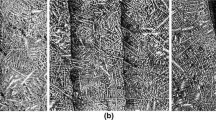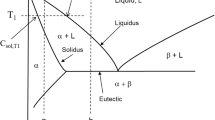Certain general trends in the radial and axial distribution of segregates in forging ingots are identified based on computer modeling and a generalization of data from studies of chemical heterogeneity in such ingots. Recommendations are developed on optimizing the geometry of forging ingots to minimize this heterogeneity.










Similar content being viewed by others
References
V. D. Dub, Investigation of Nonaxial Segregation and Development of Methods of Suppressing It in Forging Ingots: Eng. Sci. Doct. Dissert., Moscow, TsNIITMASh (1980), Vol. 1.
I. I. Makarov, Investigation of the Effect of the Parameters of Hot Tops on the Kinetics of Solidification of Steel and the Formation of Shrinkage Defects in Large Ingots: Eng. Sci. Doct. Dissert., Moscow, TsNIITMASh (1976).
N. D. Ageev, Study of Steelmaking Conditions and the Casting, Structure, and Properties of Large Ingots, TsNIITMASh Report, Moscow (1952).
A. P. Fomenko, Design and Study of a Small-Hot-Top Ingot with Conical Walls to Produce Rolled Sections: Eng. Sci. Cand. Dissert., TsNIIchermet, Moscow (2007).
A. V. Mozgovoi, Optimization of the Parameters of a Steel Ingot with Improved Axial-Zone Characteristics for the Production of Large-Diameter Rolled Sections: Eng. Sci. Cand. Dissert., TsNIIchermet, Moscow (2009).
K. Nishiguchi, K. Nakanishi, K. Nakayama, et al., “Prediction on macro segregation in large forging ingots,” 13th Int. Forgemasters Meeting, IFM 1997, Oct. 12–16, 1997, Pusan, Korea, pp. 57–70.
E. Sheil, “Bemerkungen zur schicht kristallbildung,” Zeitschrift für Metallkunde, 34, No. 3, 70–72 (1942).
J. A. Burton, R. C. Prim, and W. P. Clichter, J. Chem. Phys., 33, 723 (1955).
Y. Yamamoto, H. Muto,Y. Akimoto, et al., “Solidification analysis of mod. 9Cr–1 Mo steel,” 17th Int. Forgemasters Meeting, IFM 2008, Nov. 3–7, 2008, Santander, Spain.
K. Tashiro, Sh. Watanabe, I. Tamura, et al. “Influence of mold design on the solidification soundness of heavy forging ingot,” Transactions ISIJ, 23, 312–321 (1983).
V. S. Dub, E. V. Makarycheva, and I. I. Makarov, “The forging ingot – present and future,” Elektrometallurgiya, No. 5, 22–30 (1999).
V. A. Durynin and Yu. P. Solntsev, Study and Improvement of the Manufacturing Technology to Increase the Service Life of High-Priority Products Made from Large Forgings [in Russian], Khimizdat, St. Petersburg (2006).
V. V. Nazaratin, A. N. Romashkin, I. A. Ivanov, et al., “Method of designing forging ingots without axial shrinkage defects,” Metall. Mashinostr., No. 3, 40–52 (2010).
Author information
Authors and Affiliations
Additional information
Translated from Metallurg, No. 11, pp. 45–52, November, 2013.
Rights and permissions
About this article
Cite this article
Dub, V.S., Romashkin, A.N., Mal’ginov, A.N. et al. Effect of the Geometry of an Ingot on its Chemical Heterogeneity. Part I. Metallurgist 57, 987–995 (2014). https://doi.org/10.1007/s11015-014-9834-1
Received:
Published:
Issue Date:
DOI: https://doi.org/10.1007/s11015-014-9834-1




